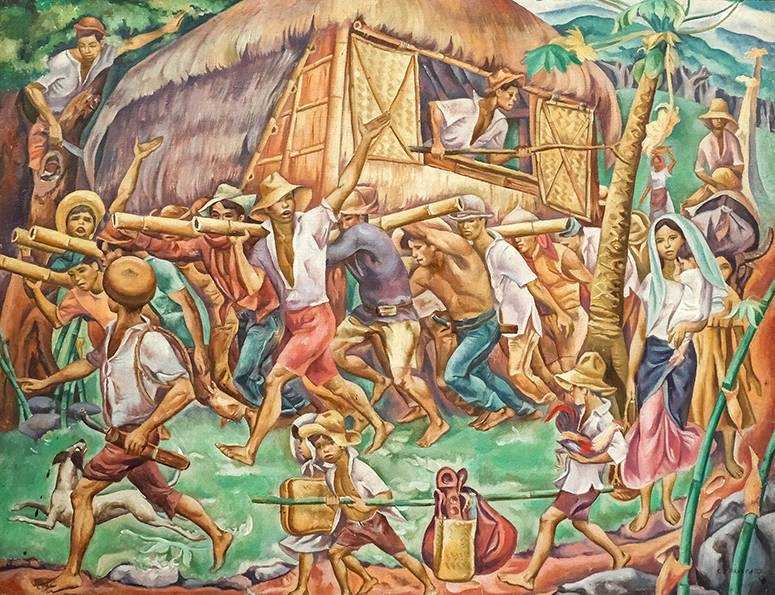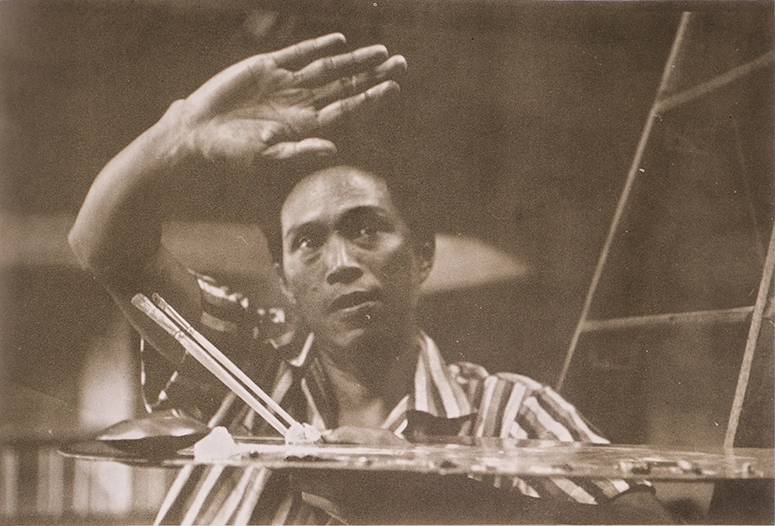Our heroic DNA: Botong, Bayani and Bayanihan
Trust National Artist Carlos “Botong” V. Francisco to tap into our heroic DNA. He was justly famous as the maker of the Filipino pantheon— Andres Bonifacio signing his Katipunan oath in blood, Jose Rizal felled by a firing squad, Lapulapu in all his majesty, and also the glorious warriors of the northern tribes and shamans of the south. But Botong was also an expert in seeing the noble in the ordinary man, represented by the men he knew the most, his fellow townspeople of Angono, Rizal.
Once in a long while, an “easel-sized” tableau—as opposed to the enormous murals Botong is known for and that is perhaps more suitable to a modern vertical domicile—surfaces. For the poet of the Filipino soul, its size best suits the intimacy and immediacy of Botong’s lovable small-town vignettes.
One such masterpiece is the 1968 “Bayanihan,” commissioned by one of the most wealthy American expatriates of the era, husband and wife Herbert and Gertrud Harder. It has appeared for the forthcoming year-end sale, the León Gallery Kingly Treasures Auction this Dec. 2.
As the owner of one of the country’s biggest glove-making enterprises, Mr. Harder would receive bread-and-butter thank-you notes from no less than Mrs. Imelda Romualdez Marcos whom he would send several fashionable pairs for her and her children. He would also become pen pals with Senator Emmanuel Pelaez, who would later be appointed by another president, Corazon Aquino, as Philippine ambassador to the United States.
Harder, according to his wife Gertrud’s handwritten account, had an employee who happened to be a friend of Botong and arrangements were made for them to meet. It’s the kind of charming bonhomie that fits Botong’s character entirely.

This particular painting is a rare oil rendition of the original mural-sized work in the collection of a huge Filipino corporation. Moreover, it depicts that unique interplay of language and history that is emblematic of the Filipino spirit—and Botong Francisco.

For in the work “Bayanihan” he explores the very meaning of the word “bayan” which itself finds its root from the ancient word for “bahayan” or home. A group of houses (or bahay) counted as one would thus comprise a “bayan,” and the man who would be its stoutest and most valiant defender was called a “Bayani.” Botong would thread all these meanings into a single powerful image that would embody the communal spirit of the Filipino.

“Bayanihan” is thus a cinematic work, with its central figure, the “Bayani.” He is a charismatic lider, dressed in the sartorial shorthand that we have come to identify with another great man, Andres Bonifacio: the white shirt and peasant’s red trousers. He summons—nay, exhorts and inspires—his friends, numbering a dozen apostles depicted in the work, to throw their shoulders into the task. They are dressed in a variety of get-ups from Botong’s massive murals as well as Rizal’s novels: the farmer, fisherman, a bowler-hatted gobernadorcillo, even leading the way ahead jauntily, a tulisan or “outlaw” that recalls the Noli Me Tangere’s most romantic character, the crocodile-hunter Elias. He is wearing a salakot and is pursued by a spotted dog. It is a microcosm of our common narrative—and dovetails gracefully with this year’s marking of our country’s 125th year of the birth of a nation.
The entire bayan is called to join together in this powerful scene taken from the dynamic theater of Filipino life—the mother clasping a child in swaddling clothes; behind her, the helpful, omnipresent elder sister (or ate); the dutiful older son (or kuya), cradling his father’s prized possession, a fighting cock; a little brother and sister (bunso). The tyke carries a bayong with a carefully collected storehouse of toys, including a sungkaan and cooking spoons, while the youngest prances boldly with a tampipi (or woven traveling case). There are other characters to be found, the same as there are in all the villages across the country—a man on a carabao, another in a straw bowler, a fruit-gatherer perched high in a tree’s branches, but ready this time to lop them off with a sharp bolo to make way for the bahay kubo’s thatch roof. (He is recognizable as the cook sampling the sinigang in another Botong work with the theme Fiesta of Angono). Another makes way for the house borne on shoulders—pushing aside a leaning papaya tree, to be found everywhere on Philippine country roads, with a sungkit.
Their one task is the Bayanihan, which folds back inexorably to the very meaning of bayan. This mythical Bayanihan supports nothing less than our own homeland, and, to carry it forward, the nation must move as one: for only sinew and grit—and a sense of brotherhood and a greater community—can carry it aloft.


